Artists/Bands [A]
NB: If an individual’s Christian or surname is currently unknown this is indicated by an asterisk placed between brackets [*].
ALEPH
(1974-1983)
- Personnel: Mary Jane Carpenter (keyboards/vocals) ▪ Ron Carpenter (drums/ vocals) ▪ Dave Froggatt (guitars) ▪ Mary Hanson (keyboards/vocals) ▪ Dave Highet (bass/flute) ▪ Joe Walmsley (vocals)
- Also known as: Takeaways (ca. 1979/1980)
Although based out of Sydney beginning in 1974, and later on the New South Wales North Coast, Aleph’s connection with the Northern Tablelands was through Ron Carpenter, Dave Froggatt and Dave Highet, all of whom were former members of the Armidale band Bogislav. Aleph was initially a six-piece outfit which performed an all original repertoire. Utilising Mellotrons, moogs, Oberheim synths and elaborate guitar effects, along with traditional rock instruments, the band’s music during the early years has been described as full-blown, complex symphonic rock in the vein of Yes, Genesis and King Crimson. In this respect the band, along with Sebastian Hardie, helped pioneer the art/prog rock genre in Australia.
At the end of 1974 Aleph recorded six songs at Sydney’s Albert’s Studios. Another band recording its debut album there at that time was AC/DC. Interestingly a connection existed between the two bands through Ron Carpenter. The drummer had only recently left AC/DC after having spent much of 1973 and 1974 playing in several of its early line-ups (AC/DC and Aleph later even played a gig together at the Sydney Haymarket ca. 1976/76). By late 1974 Aleph had also begun playing gigs around Sydney, and over the next few years steadily built a following through its consistently high level of musicianship. The band also secured a contract with Warner Brothers around this time.
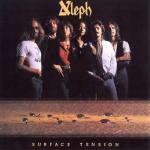 Although Aleph’s reputation as one of the country’s leading art rock bands was building, these early years were quite difficult, with a number of factors conspiring against the possibility of national success. The most serious was the band’s 1976/77 national tour which unfortunately resulted in a significant financial loss. The recording quality of the debut album, Surface Tension, was also deemed unacceptable by the band and they subsequently asked Warner Brothers to allow them to re-record the songs. Warner denied the request, however, and went on to release the LP in 1977. This eventually led to the band and record company terminating their association. Aleph then lost lead singer Joe Walmsley to illness in 1978, and that same year had its custom PA repossessed as a result of being $400,000 in debt. The band was later forced to abandon its touring for several months after Ron Carpenter was asked to fill in as temporary drummer for Cold Chisel. Carpenter also spent much of 1979 pouring his energies into the band First Light, which recorded and released a self-financed album that same year.
Although Aleph’s reputation as one of the country’s leading art rock bands was building, these early years were quite difficult, with a number of factors conspiring against the possibility of national success. The most serious was the band’s 1976/77 national tour which unfortunately resulted in a significant financial loss. The recording quality of the debut album, Surface Tension, was also deemed unacceptable by the band and they subsequently asked Warner Brothers to allow them to re-record the songs. Warner denied the request, however, and went on to release the LP in 1977. This eventually led to the band and record company terminating their association. Aleph then lost lead singer Joe Walmsley to illness in 1978, and that same year had its custom PA repossessed as a result of being $400,000 in debt. The band was later forced to abandon its touring for several months after Ron Carpenter was asked to fill in as temporary drummer for Cold Chisel. Carpenter also spent much of 1979 pouring his energies into the band First Light, which recorded and released a self-financed album that same year.
In 1979 Carpenter convinced the remaining members of Aleph (and their families) to relocate to Byron Bay where the band subsequently based itself. That same year Mary Hanson, Dave Froggatt, Dave Highet, and Ron Carpenter recorded an album under the band name Takeaways. The sessions were undertaken at The Shed, Byron Bay, New South Wales, and produced by the band, with Highet, Carpenter and Froggatt doubling as engineers. The album was mixed at the Music Farm (Byron Bay) by engineer John Sayers, mastered at EMI Studios 301 (Sydney), and released the following year on the Global Records label (YPRX 1759). No other recordings from this label have been identified suggesting that it was likely a custom recording released by the band. All songs were by Dave Froggatt.
Over the next few years the Aleph/Takeaways line-up whittled down from a five piece to quartet and finally a trio, with Carpenter eventually taking on lead vocal duties. Although conceived as an all-originals band, Aleph had by this stage been forced to play a selection of covers – with these ranging from punk and new wave to electronica and classic rock. The creative decisions in this area worked well and the band managed to secure almost nightly gigs throughout Northern New South Wales and the Queensland Gold Coast through until 1983. Carpenter has since recalled that the band also eventually managed to pay off most of its previous debt.
Along with Idol Minds (Lismore), Aleph is considered to have been one of the most popular and hardest working bands to come out of the New South Wales North Coast during the pub rock era.
Aleph. “Banshee.” (1977) [music/lyrics: Ron Carpenter] From Surface Tension .
Takeaways. “Here Comes the Octopus.” (1988) [music/lyrics: Ron Carpenter] From Crunch Time.
- Discography [pdf] incl. Takeaways
- Several YouTube channels have published the complete Surface Tension album. A high audio quality version can be accessed, for example, at Aleph Surface Tension 1977 [ctd. 4/05/2023]. You can also listen to all tracks from both Surface Tension and the Takeaways album Crunch Time at the AVTA’s Music Hub 2 pages (A-L and M-Z respectively).
Sources: Ron Carpenter (buoy.com article, 2006 – see Carpenter’s NTMIA entry for PDF reprint) • “Aleph” (alexgitlin.com). Images: sourced courtesy of alexgitlin.com. †
ALLEN, PETER
See: Northern Tablelands – B: Live Entertainment History [1880s-1960s] “Regional Overview” section
JEN ANDERSON
-
Bands : Barb Walters and the Men of Constant Sorrows ▪ The Black Sorrows ▪ Giant Steps ▪ The Jen Anderson Band ▪ Kings of the World ▪ The Larrikins ▪ Mixt Company ▪ Scarecrow ▪ Sonic Lifeform ▪ The Stab ▪ Tim Rogers and the Twin Set ▪ Weddings, Parties, Anything
Violin/viola/guitar/bass/mandolin/keyboards/vocals/composer/producer.
Born into a musical family, Jen Anderson’s father Professor Gordon Anderson was a professional jazz musician before becoming Australia’s foremost expert in medieval music. She and her younger brother Jon were encouraged to learn an instrument from an early age, with Jen choosing the violin with Jon taking up trumpet and later guitar. The family moved to from Adelaide to Armidale in 1973 following her father’s appointment as lecturer in Medieval and Renaissance music at the University of New England’s new Department of Music. Jen and Jon initially attended Armidale High School before moving to the newly established Duval High School in 1974.
During her late-teens and early-twenties Anderson became interested in playing more contemporary music and realising that violin had a limited place in rock music took up the bass guitar. By the mid-1980s she was a member of Mixt Company, a six-piece band initially based in the mid-north coast area of New South Wales (around Macksville and Kempsey). It later became Giant Steps and established a new base out of the Lismore/Byron Bay in the North Coast region. After a number of line-up changes the group eventually disbanded around 1988/89. In addition to Anderson, other members have included: Barry Ferrier (guitar), Lisa Spence (vocals), Tim Shanasy (keyboards), Gordon Heazlewood (drums), Richard Rummery (keyboards/guitar).
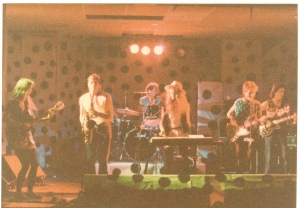 Mixt Company at the Imperial Hotel, Armidale 1983. [Heather Grigg]
Mixt Company at the Imperial Hotel, Armidale 1983. [Heather Grigg]
Between 1989 and 1992 Anderson was associated with Kings of the World (1989), Scarecrow (1991) and The Stab (1992). The two later bands included musicians who have also played with her in Weddings Parties Anything – Stephen O’Prey (Scarecrow) and Dave Steel (The Stab). In 1992, while playing in a duo on one of the floors of the Sydney Trade Union Club, Anderson’s talent as a violinist was noticed by Joe Camilleri. The Black Sorrows frontman (formerly with Jo Jo Zep and the Falcons) was in the process of expanding his band’s line-up and invited her to join the group. She soon afterwards appeared on The Black Sorrows’ hit LP Harley and Rose and toured throughout Australia and overseas, cementing her reputation as one of Australia’s leading contemporary violinists.
While still with the Black Sorrows Anderson released a solo EP Seek (1992) which includes some members of the band, along with drummer Gordon Heazlewood (ex-Mixt Company and Giant Steps. Seek contains a variety of styles and moods through which Anderson experiments with instrumentation and various pop-writing styles. During this period she also toured briefly with her own group (the Jen Anderson Band), comprising ex-Jo Jo Zep and the Falcons guitarist/vocalist Tony Faehse, along with Tim Henwood, (guitar, vocals), Pat Quinn (bass, vocals) and Terry Bartholmew (drums). The Black Sorrows released Better Times in 1992 and continued touring, while also releasing a number of singles up until late 1993 when Camilleri disbanded the group.
Having recorded several tracks for Weddings, Parties, Anything on the band’s albums Different Loves (1992), including a feature appearance on the band’s most successful single, “Father’s Day” and King Tide (1993), Anderson was an obvious choice as permanent violinist, and subsequently joined in 1994. Her first album release as an official member was Donkey Serenade (1995). Anderson remained with the band until it disbanded in 1998, but has also been involved in several reunions – 2005, 2006 (a one-off) and 2008. Although Weddings Parties Anything had limited commercial success its live shows were renowned for being energetic, and the band toured extensively throughout Australia.
While still a member of Weddings Parties Anything Anderson was also carving out a successful career as a soundtrack composer and session musician. One of her early solo projects involved writing and recording the soundtrack to the German silent movie Pandora’s Box (starring Louise Brooks). Anderson performed the soundtrack live during its 1993 art house run. That same year she produced Ruby Hunter’s debut album Thoughts Within, while also contributing violin and viola fills to a couple of the tracks.
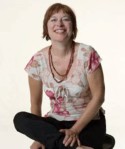 Since 1993 Anderson has contributed to more than 40 recordings as a guest musicians, including works by Hunters and Collectors, The Revelators (with Joe Camilleri), Billy Baxter, Deborah Conway, Nick Cave, Renee Geyer, Dave Graney and the Coral Snakes,Sherry Richand the Grievous Angels, along with three tracks from the 1998 compilation Didj’un : Singer Songwriters from the Kimberley. She also features on the Nick Cave/Kylie Minogue hit single, “Where the Wild Roses Grow,” taken from the album Murder Ballads (1996), and produced and played violin on Tim Rogers’ and The Twin Set’s 1999 Aria award-winning release What Rhymes with Cars and Girls (Rogers is perhaps best known as the frontman for You Am I. In addition to her recording career Anderson continues to tour and perform with other musicians and bands, including, for example,Barb Walters and the Men of Constant Sorrow (2002).
Since 1993 Anderson has contributed to more than 40 recordings as a guest musicians, including works by Hunters and Collectors, The Revelators (with Joe Camilleri), Billy Baxter, Deborah Conway, Nick Cave, Renee Geyer, Dave Graney and the Coral Snakes,Sherry Richand the Grievous Angels, along with three tracks from the 1998 compilation Didj’un : Singer Songwriters from the Kimberley. She also features on the Nick Cave/Kylie Minogue hit single, “Where the Wild Roses Grow,” taken from the album Murder Ballads (1996), and produced and played violin on Tim Rogers’ and The Twin Set’s 1999 Aria award-winning release What Rhymes with Cars and Girls (Rogers is perhaps best known as the frontman for You Am I. In addition to her recording career Anderson continues to tour and perform with other musicians and bands, including, for example,Barb Walters and the Men of Constant Sorrow (2002).
Anderson’s own releases include a collaboration with pianist Tim Shanasy (as Sonic Lifeform). They released Silent Catalyst in 1999. Her critically acclaimed score for Pandora’s Box led to a commission from ScreenSound Australia to write the music to accompany a reconstructed version of the original 1919 silent film The Sentimental Bloke for the 1995 Melbourne International Film Festival. She and fellow Weddings Parties Anything compatriots Mick Thomas and Mark Wallace helped record the soundtrack (released in 2004) and played live during the films initial Australian tour. Following the discovery of new footage a new reconstruction of the film premiered in 2004, Anderson was again asked to perform the score live (with some additional new music). She subsequently formed The Larrikins, comprising Anderson (strings/mandolin/vocals), Dave Evans (keyboards/piano accordion/vocals) and Dan Warner (guitar/mandolin/vocals). In addition to a 2004 Australian national tour the trio has toured extensively overseas, including playing at high profile film festivals in London and Pordenone (2005); Telluride, Washington DC, Montreal and Tokyo (2006); and Seattle and Seoul (2007).
Jen Anderson’s film and television credits also include the ABC’s Simone de Beauvoir’s Babies and ‘Wee Jimmy’ (from the Hybrid Life series); the Clara Law film Goddess of 1967 (2001); the short films Tale of the Paper Hearts (1998) and Helga: Adrift in Wonderland (2002) ; and the documentaries It’s Like That (2003), Einstein’s Wife: The Life of Mileva Einstein-Maric (2003), Hunt Angels (2006) and Vivian Bullwinkel (2007).
Jen Anderson. “Bill and Doreen.” [2004] [music/lyrics: Jen Anderson] From The Sentimental Bloke soundtrack (Head Records] Featuring Mick Thomas (vocals).
Sonic Lifeform. “Ancestral Encounter.” (1999) [music: Jen Anderson and Tim Shanasy] From the album Silent Catalyst.
Jen Anderson. “Lulu’s Song.” (1993) [music/lyrics: Jen Anderson] From the Pandora’s Box soundtrack (Valhalla Cinema).
Jen Anderson. “Never the Same.” (1992) [music/lyrics: Jen Anderson. From the EP, Seek (Chapel of Change).
Giant Steps. “Tell Me” (ca. mid-1980s) [music/lyrics: Jen Anderson] Recorded live at Lennox Heads, NSW.
Giant Steps. “Much More” (ca. mid-1980s) (music/lyrics: Jen Anderson) Promotional video (courtesy of Barry Ferrier – Dr Baz.com)
– Video clips for the two Giant Steps songs above have been published on YouTube courtesy of Barry Ferrier. See also his “Giant Steps” page at the Dr Baz website [sighted 26/06/23]
– Seek, Pandora’s Box, Silent Catalyst and The Sentimental Bloke are all available for purchase from Head Records or can be accessed via Spotify and iTunes.
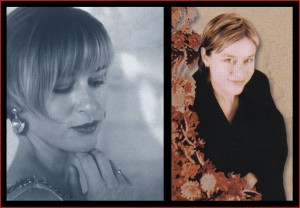 L: from Pandora’s Box CD, 1993 [Rainford] R: from The Sentimental Bloke CD, 2004 [Rachel Dean]
L: from Pandora’s Box CD, 1993 [Rainford] R: from The Sentimental Bloke CD, 2004 [Rachel Dean]
- To hear a selection of songs by Jen Anderson visit: Jen Anderson (website) [sighted 8/05/2023]
- Discography 1 [pdf] as solo artist and band member
- Discography 2 [pdf] as guest musician, contributor and/or producer
- Filmography [pdf] soundtracks and music clips
- Further reference: Jo Roberts, “Weddings Parties Anything Return” Age 16 Apr. (2008) • Michael Winkler, “Puts Strings to Her Beau” Age 26 Oct. 2004 • Dan Warner website •
- For more information on Professor Gordon Anderson see the University of New England Library’s Gordon Athol Anderson Music Collection page, which includes links to a biography of scholarly achievement and bibliography of publications.
Sources: Clay Djubal. “Jen Anderson.” AustLit: The Australian Literature Resource (2008-10) • Ian McFarlane, Encyclopedia of Australian Rock and Pop. Images: Top photo courtesy of Last.fm (online)† • 5th photo from top courtesy of Jen Anderson • Album images courtesy of Head Records† • Larrikins photo courtesy of the National Film and Sound Archive † • Weddings Parties Anything photo by James Brickwood, courtesy of The Age (16 Apr. 2008).
JON ANDERSON
-
Bands : Crash Landing ▪ Delilah ▪ Elsess ▪ Helga ünd der Blitzkrieg ▪ It’s Not Us ▪ Pantor ▪ Shoot the DJ
Guitar/vocals/trumpet/sound
The younger brother of Jen Anderson (see above), Jon learned trumpet from an early age and in his early teens took up guitar (specialising in rhythm). After moving from Adelaide to Armidale with his family in 1973 he briefly attended Armidale High School before enrolling at Duval High in its foundation year (1974). While there he joined his first band, Elsess, and through the influence of his older sister became well-known among within the local alternative lifestyle and music scenes. Anderson recalls, for example, spending many weekends jamming and hanging out at the old Rockvale Pub as a 15-16 year old. After leaving school he did an apprenticeship and took up what would be a long term career with Telecom (later Telstra).
Although Anderson’s job entailed a great deal of travelling around Northern New South Wales working on relay stations, he nevertheless found time to continue his passion for music. In 1982 became a member of Crash Landing (1982), and after that band broke up he and Clay Djubal formed the nucleus of Shoot the DJ, initially with Doiran James (guitar) and multi-instrumentalist Dick Rummery on drums.
In early 1983 Shoot the DJ cemented its line-up with Ziggy Mirza (lead guitar) and Ian Mitchell (drums). A technician with Telecom (later Telstra) Anderson also operated his own business Wattamega Sound, hiring out the company’s PA to Shoot the DJ and other local bands. When the other three members of Shoot the DJ relocated to Sydney in 1984 Anderson remained in Armidale, continuing to operate Wattamega for a number of years. He was played briefly a member of the reggae-inspired group It’s Not Us (later Thunderheads).
Anderson’s major musical project after Shoot the DJ was the punk/alternative outfit Helga ünd der Blitzkrieg with former Elsess band mate Peter ‘Groover’ Makeham and singer Karin Moorehouse (aka Helga). The band enjoyed local success until 1986 at which time it disbanded following a Northern New South Wales tour with Shoot the DJ (II). Anderson and Moorehouse put together a new line-up later the same year which saw the band’s sound and repertoire move towards the more commercial pop punk genre. Freed from solo guitar duties by the inclusion of Dave Morris in the band, Anderson distinguished the band from other local groups by returning occasionally to the trumpet. Helga ünd der Blitzkrieg continued through to 1987 before disbanding.
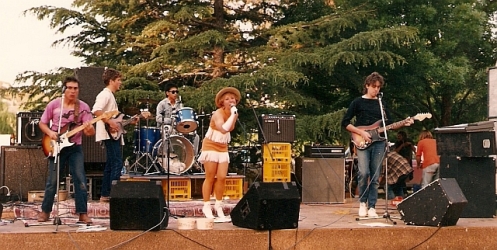 With Helga ünd der Blitzkrieg (1987)
With Helga ünd der Blitzkrieg (1987)
 Anderson continued to maintain his connection with the region’s music industry both through Wattamega Sound and as a member of various local bands, including It’s Not Us (ca. 1990s). In the late-1980s he also led a collective of local musicians in forming The Musicians Club. Among the initial members who assisted in giving the idea impetus were Richard Rummery and Peter Makeham. A response to the difficulties faced by emerging bands in trying to get gigs in Armidale, the club continued to support the local industry up until the early-2000s. Since then Anderson has largely retired from active involvement in the industry. He occasionally performed with the band Delilah (also comprising drummer, Ian Mitchell), and in 2018 joined with three friends to form Pantor The quartet became known throughout the region for its “eclectic covers of happy tunes with a Latin-World twist.” In the 2020s Anderson remains a seminal figure in the pub rock and post-pub rock New England music industry.
Anderson continued to maintain his connection with the region’s music industry both through Wattamega Sound and as a member of various local bands, including It’s Not Us (ca. 1990s). In the late-1980s he also led a collective of local musicians in forming The Musicians Club. Among the initial members who assisted in giving the idea impetus were Richard Rummery and Peter Makeham. A response to the difficulties faced by emerging bands in trying to get gigs in Armidale, the club continued to support the local industry up until the early-2000s. Since then Anderson has largely retired from active involvement in the industry. He occasionally performed with the band Delilah (also comprising drummer, Ian Mitchell), and in 2018 joined with three friends to form Pantor The quartet became known throughout the region for its “eclectic covers of happy tunes with a Latin-World twist.” In the 2020s Anderson remains a seminal figure in the pub rock and post-pub rock New England music industry.
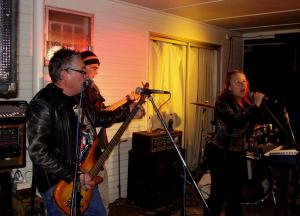 A Helga and the Blitzkrieg reunion – Jon Anderson’s 50th birthday (Aug. 2010)
A Helga and the Blitzkrieg reunion – Jon Anderson’s 50th birthday (Aug. 2010)
Crash Landing. “In the City” (1982) Jon Anderson (lead vocals/guitar). Guest musician, Dick Rummery (drums). Recorded by Peter Stanley, Muscle Studio, Armidale, NSW.
Shoot the DJ. “Paradise” (1983) Jon Anderson (lead vocals, guitar). Recorded live at the Imperial Hotel, Armidale.
Helga ünd der Blitzkrieg. “Stonehenge” (1987). Jon Anderson (trumpet). Recorded live at Sunray Sunday ’87.
- See also the NTMIA entries for the Armidale Musicians Club [Industry: A-F] and Wattamega Sound [Industry: S-Z]
- For additional details on Jon Anderson’s early life and his father, Gordon Anderson see Jen Anderson’s entry (above).
- See also: Pantor website [sighted 4/06/2023]. A clip of Anderson, Dave Morris and Karen Moorhouse performing “Another Girl” at Peter Makeham’s wake in December 2012 can be viewed on YouTube [sighted 4/06/2023].
- Discography [pdf]
– Source: Jon Anderson (interview, 2009). Images: Helga ünd der Blitzkrieg courtesy of Jon Anderson. All other photos courtesy of Clay Djubal; Wattamega Sound image courtesy of Jon Anderson. More songs featuring Jon Anderson can be heard in the entries for Crash Landing, Shoot the DJ and Helga ünd der Blitzkrieg
– “In the City” written by Paul Weller (The Jam). “Paradise” written by C.J. Bailey (The Saints). “Stonehenge” written by Peter Makeham (Helga ünd der Blitzkrieg).
AQUARIUS
(1976-1982)
- Personnel: Dick Kayler (drums) ▪ Jimmy Mitchell (drums) ▪ Tom Roach (bass/vocals) ▪ Peter Stanley (guitar/vocals) ▪ Geoff Walsh (drums) ▪ John Walsh (guitar) ▪ Geoff Wilson (guitar/vocals) ▪ Ray Wilson (vocals).
Aquarius formed in January 1976, taking the astrological sign which was then current. With all the members then being in their thirties, the music not surprisingly drew on the rock ‘n’ roll era of the late 1950s and early 1960s – with music by such artists as Elvis Presley, Bill Haley, Jerry Lee Lewis, Guy Mitchell, Buddy Holly etc. The band’s repertoire also comprised occasional country or middle-of-the road numbers which widened its appeal. These songs were generally sung by Tom Roach.
 Aquarius’ first gig was at the Glen Innes Services Club, followed by the Uralla Golf Club. After playing several private parties the band began securing regular work around the regions. One of the main venues during the early years was the Seven Brothers Restaurant (Armidale), which had an upstairs auditorium that was used regularly for weddings and private parties (one memorable show saw the band play support for Jade Hurley). After performing at a private function at the Armidale Ex-Services Club, Aquarius was booked to play the Auditorium every second Saturday, in addition to Christmas Eve and New Year’s Eve. A desperate phone call from Uralla Bowling Club one Saturday afternoon (the club needed a band that night) also led to a permanent booking for one Saturday every month from then on.
Aquarius’ first gig was at the Glen Innes Services Club, followed by the Uralla Golf Club. After playing several private parties the band began securing regular work around the regions. One of the main venues during the early years was the Seven Brothers Restaurant (Armidale), which had an upstairs auditorium that was used regularly for weddings and private parties (one memorable show saw the band play support for Jade Hurley). After performing at a private function at the Armidale Ex-Services Club, Aquarius was booked to play the Auditorium every second Saturday, in addition to Christmas Eve and New Year’s Eve. A desperate phone call from Uralla Bowling Club one Saturday afternoon (the club needed a band that night) also led to a permanent booking for one Saturday every month from then on.
 Among the other venues the band played were: Walcha Bowling Club, Walcha Race Club Ball, Armidale Bowling Club, Armidale Golf Club, Wright College (UNE), Tamworth Services Club, Ashford Nurses’ Ball, Bundarra, Armidale Race Club Ball (at the racetrack).
Among the other venues the band played were: Walcha Bowling Club, Walcha Race Club Ball, Armidale Bowling Club, Armidale Golf Club, Wright College (UNE), Tamworth Services Club, Ashford Nurses’ Ball, Bundarra, Armidale Race Club Ball (at the racetrack).
In early 1979 Geoff Wilson moved to Queensland and was replaced by Peter Stanley who had recently returned from Sydney. Stanley’s influence saw the band broaden its repertoire to include songs from the mid-late 1960s (particularly those by The Beatles) and some material from the 1970s. Eventually drummer Geoff Walsh left the band, to be replaced by Dick Kayler. By this stage Aquarius had moved away from pub gigs and was playing the Northern tableland’s club circuit almost exclusively. Following Dick Kayler’s departure in late 1981 Jimmy Mitchell (formerly of Sydney) joined the band.
By mid-1982 Aquarius’ hectic workload had become to much for the members and their families (along with their other work commitments), and it was mutually decided to make that year’s New Year’s Eve gig at the Armidale Ex-Services Club its finale. The band’s popularity meant that each of final club gigs during the second half of the year became special events. The New Year’s Eve show, presented along with Pete Raymond’s disco, saw the Auditorium packed by 6.30pm, with some 750 people having turned up to say farewell. The show finished at 2 am on 1 January 1983, and is still remembered today by those who attended.
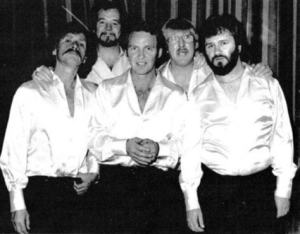 Aquarius ca. 1980/81.† L-R: John Walsh, Jimmy Mitchell, Tom Roach, Ray Wilson, Peter Stanley.
Aquarius ca. 1980/81.† L-R: John Walsh, Jimmy Mitchell, Tom Roach, Ray Wilson, Peter Stanley.
Source: Entry adapted from band bio (courtesy of Ray Wilson – thanks to Brian and Tricia Moore). Images: All images sent courtesy of Ray Wilson – thanks to Brian and Tricia Moore (†)
ARMIDALE BUSH BAND
aka Rod Noble Bush Band
(1975 -1977 )
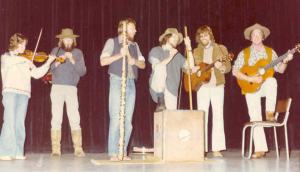 Playing at the Armidale Ex-Services Memorial Club, 1976
Playing at the Armidale Ex-Services Memorial Club, 1976
- Personnel incl. Carol Clifford (fiddle) ▪ Phil Craven (lager phone/vocals) ▪ Peter Faircloth (lead vocals/guitar) ▪ Rod Noble (bush bass/ vocals) ▪ Ian Reeve (accordion/tin whistle) ▪ Phil Ryan (guitar)
The Armidale Bush Band formed towards the end of 1975 when a few young residents of Armidale and Uralla got together to share their interest in early Australian music. The band’s first gig at at the University of New England (UNE Bistro) was advertised in Neucleus as the Rod Noble Bush Band. According to Noble its management placed the ad in the student newspaper just prior to the deadline but couldn’t remember the band’s name. As Noble was a well-known university identity they used his name (correspondence, Apr. 2010). The Armidale Bush Band’s repertoire comprised more than forty numbers, including classic songs like “Ryebuck Shearer” “Lazy Harry’s,” “Botany Bay,” “The Wild Colonial Boy” and “The Overlanders.” An Irish influence could also be heard in songs like “Wild Rover” and “Black Velvet Band.” Fitting in with the times, too, were a number of contemporary political songs such as “Shame, Fraser, Shame” (about Prime Minister Malcolm Fraser and his Liberal government).
Well-known in Uralla and Armidale during 1976 through regular gigs in both towns, the group’s instrumentation was distinctive in that it featured traditional bush instruments (including an old tea chest bass and lager phone) along with accordion and guitar. The group played regular Friday night gigs at the Thunderbolt Inn (Uralla) as well as making frequent appearances at the Galloping Grape Bistro (Armidale). According to Rod Noble the Thunderbolt’s Inn gigs were always packed as both the band and Inn were popular with the district’s shearers. He further recalls he further recalls that it was not uncommon for people to dance on the tables, while Carol Clifford’s traditional closing number, a solo rendition of “Danny Boy,” would often cause grown men to cry into their beers (correspondence, Jan. 2010). The band is also known to have played the UNE Bistro on a number of occasions and the Armidale Ex-Services Club once.
Despite its popularity the group disbanded in late 1976 when Noble and Faircloth were forced to leave the area for work reasons. The Armidale Bush Band’s final gigs were undertaken on a tour of the Hunter Valley in late 1976. The tour included various pubs and venues around the coal fields, including townships like Heddon Greta, Kurri Kurri and the Newcastle Folk Club. Two of the original members reprised the band in 1977, however. Another bush/folk-orientated group, Patterson’s Curse (which formed ca. 1978) also comprised several members of the Armidale Bush Band.
 In early 2009 three of the original members of the Armidale Bush band reunited to perform a series of gigs in Uralla and Armidale. Original lead singer Peter Faircloth, who had been living in England for more than 20 years, flew back to Australia to participate. Among the venues chosen was the Coachwood and Cedar Hotel-Motel (Uralla).
In early 2009 three of the original members of the Armidale Bush band reunited to perform a series of gigs in Uralla and Armidale. Original lead singer Peter Faircloth, who had been living in England for more than 20 years, flew back to Australia to participate. Among the venues chosen was the Coachwood and Cedar Hotel-Motel (Uralla).
- Repertoire [pdf]
Sources: “Bush Band to Re-unite After 33 Year Break.” Armidale Express 5 Jan. 2009, n. pag. • Rod Noble (interview and correspondence, Jan. 2010). Images: Colour photos (see also pdf document) courtesy of Rod Noble • UNE Bistro advertisement, Neucleus 7 Apr. 1976, 9.
ARMIDALE PEOPLE’S BUSH BAND
(1975)
- Personnel incl. Andy Berriman ▪ David Curtis ▪ Rod Noble
The Armidale People’s Bush Band came about in 1975 through the involvement of a number of University of New England (UNE) students and associates who were connected with the Old Rockvale Pub commune. Rod Noble, one of the People’s Bush Band founders, and a resident at the ‘pub’ between 1973 and 1976, indicates that music was integrated very much into the lives of his peers. ‘People played for each other at nearly every spare moment and at every party – and they were held with considerable regularity.’
Together with David Curtis, Andy Berriman and several other friends they formed a collective which became known as Armidale People’s Bush Band. Performing with traditional bush instruments (e.g. tea chest bass and lager phones) and acoustic guitars, fiddles etc, the group played a number of times in the Armidale Mall and at several student demonstrations and fund-raising gigs. While it did not play any licensed venues in Armidale or in nearby town, the People’s Bush Band did help establish bush music as a popular alternative to rock and jazz bands in Armidale. It was also arguably the most suitable genre for political activism at the time, being closely associated with the protest movement closely associated with such artists as Woody Guthrie, Pete Seeger, Bob Dylan and Joan Baez amongst others. Rod Noble recalls, for example, that at one of the demonstrations, held to bring attention to the plight of the East Timorese, the group performed a number of politically-charged songs, including “Red Flag” and “Bump Me Into Parliament.”
The Armidale People’s Bush Band later evolved into the Armidale Bush Band, which found much popularity in Uralla and Armidale in 1976 [see entry above].
Source: Rod Noble (interview and correspondence, Jan. 2010).
ARTISANS
(ca. late 1960s/early 1970s)
- Personnel: Greg Goldsmith ▪ Ron ‘Rocky’ Lane ▪ Ralph Monley
An acoustic covers band which played a largely folk repertoire, including renditions of songs by popular acts such as Bob Dylan and Peter, Paul and Mary.
Source: Brian Moore (interview, Aug. 2010).
THE ASTROS
(1979-1980)
![Astros [3 photos 2]](https://havegravity.files.wordpress.com/2008/10/astros-3-photos-2.jpg?w=497&h=206) L: David Morris • M: Matt Hirst • R: Rod Clay and David Morris
L: David Morris • M: Matt Hirst • R: Rod Clay and David Morris
- Personnel : Rod Clay (bass/vocals)* ▪ Matt Hirst (drums/vocals) ▪ David Morris (guitars/vocals) ▪ Richard Rummery (keyboards/guitar/bass/vocals) ▪ Michael Lomas and Craig Lomax (sound/handclaps).
The Astros was a short-lived attempt by Rod Clay and David Morris to continue the Vice Squad tradition in Sydney. The other two members of the band were former Health Club bass player Dick Rummery on keyboards and guitar, with local drummer Matt Hirst also providing lead and harmony vocals.
The band played in the inner city precincts, and mostly at parties attended by Armidale ex-pats. In despair after one disastrous gig, when half the group turned up on acid, Rod Clay took the radical step of joining the Army thus ending The Astros.
The Lomas brothers, Craig and Michael, were closely associated with the band, as was Dick Rummery’s cousin Ian Rummery who provided a sometimes rehearsal space in the lounge room of his Stanmore flat (at 30 Salisbury Road). Michael Lomas co-wrote one of the band’s songs “Waylayed” with Rod Clay. Other original songs played by the band included “Finger in the Sky” (Clay/Rummery), “Street People” (Clay), “Put the Boy Down” (James/Clay) and “Cherrie’s Got a Habit” and “The Astronauts” (both by David Morris).”
![Astros [Lomas brothers]](https://havegravity.files.wordpress.com/2008/10/astros-lomas-brothers.jpg?w=497&h=168) The Lomas brothers – Craig (far left) and Michael (far right)
The Lomas brothers – Craig (far left) and Michael (far right)
The Astros (Mk I). “The Slider” (1979, Sydney).
Recorded on a cassette player during an early rehearsal (before Matt Hirst joined), this cover of the T-Rex classic is the only known Astros recording in existence. Hand claps are by the Lomas brothers.
Shoot the DJ. “Waylayed.” (1983) [words/music: Rod Clay and Michael Lomas]
“Waylayed” was written by Clay and Lomas at 30 Salisbury Road, Stanmore (NSW), sometime in 1979. Although the song was performed live by The Astros that same year, and by Crash Landing in 1982, it was never recorded by either band. This Shoot the DJ version was produced at the Mitchell brother’s family home in January 1983. It also appears on the band’s 2023 album, Cleared for Action.
- Repertoire [pdf] incl. additional images

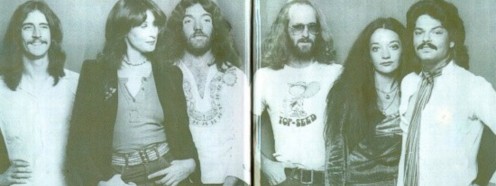
![Aleph ad [1976]](https://havegravity.files.wordpress.com/2010/03/aleph-ad-1976.jpg?w=117&h=150)

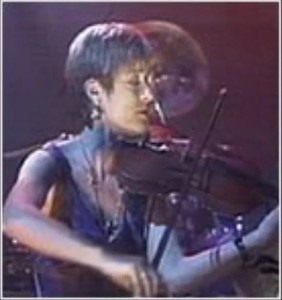
![Black Sorrows [H&R]](https://havegravity.files.wordpress.com/2008/10/black-sorrows-hr1.jpg?w=497&h=176)


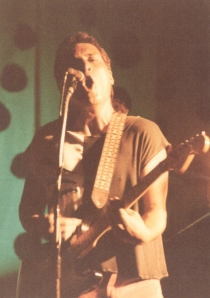

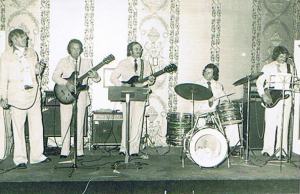

![Astros [RC & MH]](https://havegravity.files.wordpress.com/2008/10/astros-rc-mh.jpg?w=142&h=150)
![Astros [DM, ML, DR, CL]](https://havegravity.files.wordpress.com/2008/10/astros-dm-ml-dr-cl1.jpg?w=150&h=147)
